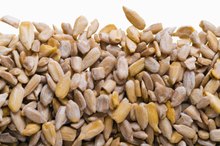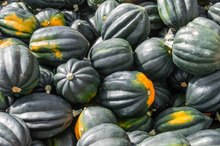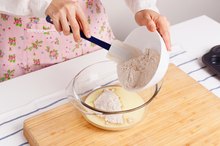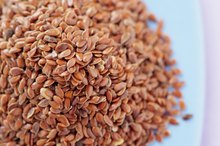How to Store & Use Chia Seeds
Chia is an edible seed from the desert plant Salvia hispanica, and was prized by the Aztecs. They are considered a “supergrain” because they contain high amounts of phytonutrients and antioxidants for disease-fighting and prevention. Chia seeds can be digested whole, do not require processing to make their nutrients available and are an excellent source of omega-3 fatty acids, antioxidants and fiber. Chia seeds are rich in essential vitamins and minerals including calcium, magnesium, potassium, copper, iron, niacin and zinc. The seeds are easy to store, prepare and consume as part of your daily diet.
Preparation and Usage
Eat chia seeds whole 1. They have a nutty flavor and suggested uses are to sprinkle them on cereal, in yogurt, in baby food, on salads or simply eaten as a snack.
How to Grind Sunflower Seeds for Omega 3
Learn More
Grind up chia seeds with a nut grinder or food processor. The ground seeds can be sprinkled on food, added to smoothies or mixed with flour to make baked goods such as muffins and quick breads. Simply replace one-quarter cup of flour with the ground chia seeds when you measure out the ingredients.
Prepare a highly digestible gel from chia seeds that can be mixed into yogurt, jellies, smoothies or other liquid-based foods.
To make chia gel, measure out one part chia seeds to nine parts water. Pour the water into a sealable container, and add the chia seeds. Mix the seeds briskly in water and allow them to sit for 30 minutes. Chia gel can be used immediately or after refrigeration.
- They have a nutty flavor and suggested uses are to sprinkle them on cereal, in yogurt, in baby food, on salads or simply eaten as a snack.
- Simply replace one-quarter cup of flour with the ground chia seeds when you measure out the ingredients.
Storage
How Much EPA & DHA Are in Chia Seeds?
Learn More
Store chia seeds in a glass or plastic storage container with a tight-fitting lid. The antioxidants in the chia seeds allow them to be stored for months in a dark, cool place.
Keep ground chia seeds (chia flour) in a glass or plastic storage container with a tight-fitting lid. The flour may be stored in a cool, dry place such as a pantry, or in the refrigerator. Chia flour, like chia seeds, may be stored for months without going rancid.
Refrigerate chia gel in a glass or plastic container with a tight-fitting lid. The gel will last about two weeks under refrigeration.
Tips
Chia gel can be used in baked goods to reduce the fat and calorie content. Replace 25 percent of the oil called for in the cake recipe with chia gel. The gel itself is flavorless, but will boost the cake’s nutritional value.
Chia gel is hydrophilic, meaning that it aborbs many times its weight in water. Use it in gel form or ingested with water to help boost your hydration intake before exercise.
If you do not have a glass or plastic container, store chia seeds in a zip-top plastic storage bag; squeeze the air out of the bag before you seal it.
- Store chia seeds in a glass or plastic storage container with a tight-fitting lid.
- Keep ground chia seeds (chia flour) in a glass or plastic storage container with a tight-fitting lid.
Related Articles
References
- Andrew Weil, M.D. : What is Chia
- Seeds, chia seeds, dried. FoodData Central. U.S. Department of Agriculture. Published April 1, 2019.
- Chia Seeds. Harvard T.H. Chan School of Public Health.
- What Are Chia Seeds. Academy of Nutrition and Dietetics. Updated 2018.
- Kulczyński B, Kobus-Cisowska J, Taczanowski M, Kmiecik D, Gramza-Michałowska A. The chemical composition and nutritional value of chia seeds-current state of knowledge. Nutrients. 2019;11(6). doi:10.3390/nu11061242
- Gutiérrez S, Svahn SL, Johansson ME. Effects of omega-3 fatty acids on immune cells. Int J Mol Sci. 2019;20(20). doi:10.3390/ijms20205028
- Improving Your Health With Fiber. Cleveland Clinic. Updated 2019.
- Imran M, Salehi B, Sharifi-rad J, et al. Kaempferol: A key emphasis to its anticancer potential. Molecules. 2019;24(12). doi:10.3390/molecules24122277
- García Jiménez S, Pastor Vargas C, De Las Heras M, Sanz Maroto A, Vivanco F, Sastre J. Allergen characterization of chia seeds (Salvia hispanica), a new allergenic food. J Investig Allergol Clin Immunol. 2015;25(1):55-6.
- Chia. Memorial Sloan Kettering Cancer Center. Updated 2019.
Tips
- Chia gel can be used in baked goods to reduce the fat and calorie content. Replace 25 percent of the oil called for in the cake recipe with chia gel. The gel itself is flavorless, but will boost the cake’s nutritional value.
- Chia gel is hydrophilic, meaning that it aborbs many times its weight in water. Use it in gel form or ingested with water to help boost your hydration intake before exercise.
- If you do not have a glass or plastic container, store chia seeds in a zip-top plastic storage bag; squeeze the air out of the bag before you seal it.
Writer Bio
Dana L. Young has been writing wellness articles since 2008. She received her Bachelor of Arts in English/creative writing from Georgia State University. Young's poetry is featured in "Another South: Experimental Writing in the South," the journal "Moria" and a chapbook, "Essential Core." She authors "Danatopia," a blog tackling such topics as modern parenting and healthy lifestyles.









